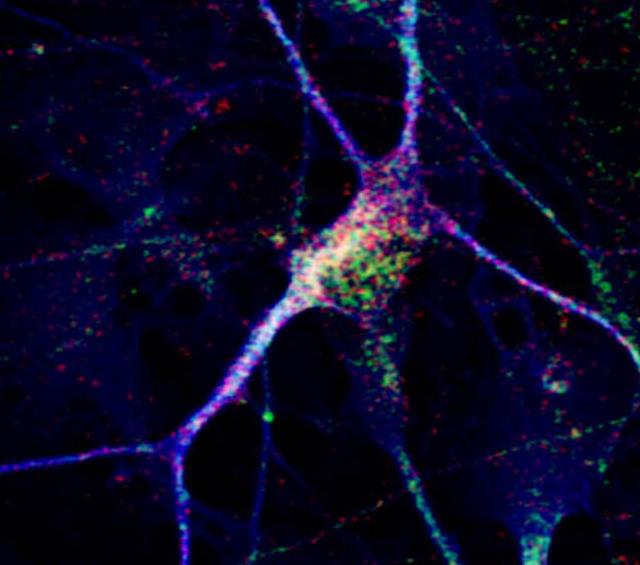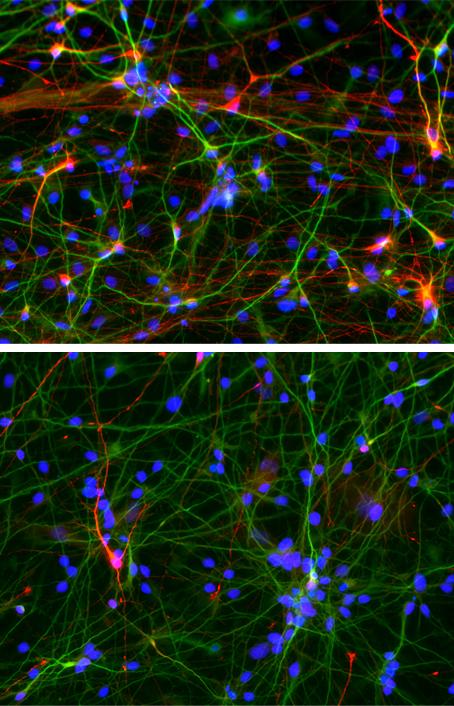Neurons grown from stem cells in a dish reveal clues about autism
July 8, 2016

Salk researchers have turned the skin cells of people with autism spectrum disorder into neurons. These cells show specific defects (indicated by red and green dots in the neuron) compared with neurons derived from healthy people, including diminished ability to form excitatory connections with other neurons (credit: Salk Institute)
Why do the brains of up to 30 percent of people with autism spectrum disorder grow faster than usual, early in life? A new study co-led by Salk Institute scientists has used a new stem cell reprogramming technique to find out.
Published July 6, 2016 in the journal Molecular Psychiatry, the Salk team found that stem cell-derived neurons made fewer connections in a dish compared to cells from healthy individuals. The scientists were also able to restore communication between the cells by adding IGF-1, a drug currently being evaluated in clinical trials of autism.*

Neurons derived from people with autism spectrum disorder, shown in the bottom panel, form fewer inhibitory connections, shown in the red stain, compared to those derived from healthy individuals (top panel). The total number of neurons that researchers were able to generate was about the same between the two groups. (credit: Salk Institute)
Autism affects approximately 1 out of every 68 children in the United States. It is characterized by problems communicating, difficulties interacting with others, and in repetitive behaviors, although the symptoms range dramatically in type and severity. There is no known cause of autism, according to the scientists.
Led by senior investigator Rusty Gage, a professor in Salk’s Laboratory of Genetics and holder of the Vi and John Adler Chair for Research on Age-Related Neurodegenerative Diseases, the researchers created stem cells from a subset of people with autism whose brains had grown as much as 23 percent faster than usual, but had subsequently normalized.
Improvement by adding IGF-1
The neuron precursor cells derived from the patients multiplied faster than those of typically developing individuals. The finding supports a theory some experts have put forth that brain enlargement is caused by disruptions to the cell’s normal cycle of division, the researchers say. In addition, the stem cell-derived neurons of individuals with autism behaved abnormally, bursting with activity less often compared with those cells of healthy people.
Those neurons’ activity seemed to improve by adding IGF-1, which is known to enhance the connections between neurons. The group plans to use the patient cells to investigate the molecular mechanisms behind IGF-1’s effects, in particular probing for changes in gene expression with treatment.
Other authors on the study include researchers from the University of California, San Francisco; the University of California, Los Angeles; the University of California San Diego; Case Western Reserve University, University of Rochester School of Medicine and Dentistry, and Icahn School of Medicine at Mount Sinai.
The research was supported by the California Institute for Regenerative Medicine, the National Institutes of Health, The International Rett Syndrome Foundation, a NARSAD Independent Investigator Award, a NIMH Autism Center of Excellence Program Project grant, The Leona M. and Harry B. Helmsley Charitable Trust, The JPB Foundation, the Robert and Mary Jane Engman Foundation, the CDMRP Autism Research Program, the University of California, San Diego Clinical and Translational Research Institute, and Autism Speaks.
* In 2010, Gage, Carol Marchetto of Salk’s Laboratory of Genetics, Alysson Muotri of the University of California, San Diego, and their collaborators showed they could recreate features of Rett syndrome—a rare disorder that shares features of autism but is caused by mutations in a single gene—in a petri dish.
They did so by taking skin cells from patients, adding a mix of chemicals that instructed those cells to form stem cells, and in turn, coaxing their new stem cells into neurons. The ability to form what’s called induced pluripotent stem cells (iPSCs) from human cells was pioneered by researchers in 2007, but some scientists were initially skeptical that the new technology could lend insight into complex heritable disorders such as autism.
“In that study, induced pluripotent stem cells gave us a window into the birth of a neuron that we would not otherwise have,” says Marchetto, a senior staff scientist and the study’s first author. “Seeing features of Rett syndrome in a dish gave us the confidence to next study classical autism.”
Abstract of Altered proliferation and networks in neural cells derived from idiopathic autistic individuals
Autism spectrum disorders (ASD) are common, complex and heterogeneous neurodevelopmental disorders. Cellular and molecular mechanisms responsible for ASD pathogenesis have been proposed based on genetic studies, brain pathology and imaging, but a major impediment to testing ASD hypotheses is the lack of human cell models. Here, we reprogrammed fibroblasts to generate induced pluripotent stem cells, neural progenitor cells (NPCs) and neurons from ASD individuals with early brain overgrowth and non-ASD controls with normal brain size. ASD-derived NPCs display increased cell proliferation because of dysregulation of a β-catenin/BRN2 transcriptional cascade. ASD-derived neurons display abnormal neurogenesis and reduced synaptogenesis leading to functional defects in neuronal networks. Interestingly, defects in neuronal networks could be rescued by insulin growth factor 1 (IGF-1), a drug that is currently in clinical trials for ASD. This work demonstrates that selection of ASD subjects based on endophenotypes unraveled biologically relevant pathway disruption and revealed a potential cellular mechanism for the therapeutic effect of IGF-1.